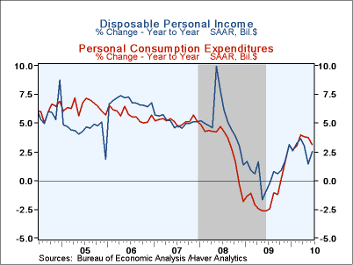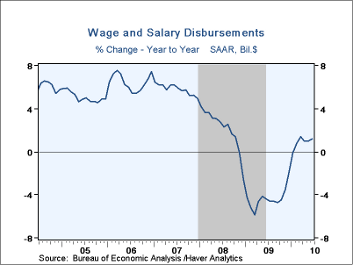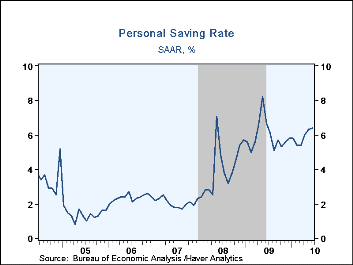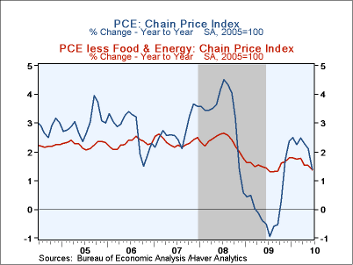 Global| Aug 03 2010
Global| Aug 03 2010U.S. Personal Income & Spending Are Stable But Revisions Raise Savings
by:Tom Moeller
|in:Economy in Brief
Summary
A soft labor market continued last month to exact its toll on income growth. Personal income during June was unchanged after a downwardly revised 0.3% May gain. A 0.2% increase had been expected. Revisions to the last three years' [...]
A soft labor market continued last month to exact its toll on income growth. Personal income during June was unchanged after a downwardly revised 0.3% May gain. A 0.2% increase had been expected. Revisions to the last three years' figures were minor except for a lift to growth during 2008. Last month's stability reflected a 0.1% dip in wages & salaries after two months of 0.4% increase. Nevertheless, the modestly improved labor market helped wages rise 1.2% y/y after the 4.3% decline during all of last year. Factory sector wages fell 0.9% and gave back nearly all of their downwardly revised May increase. Nevertheless, improved productivity helped wages rise 1.4% y/y. Service sector wages ticked up 0.1% (1.7% y/y) and were improved from the 4.1% drop during all of last year. Government wages slipped 0.1% (+1.5% y/y). Proprietors' income rose a greatly improved 4.6% y/y after last year's 8.2% drop while the decline in interest income moderated to 2.2%. Improved corporate profits led to an improved 3.0% y/y rise in dividends.
In light of modest income growth, personal consumption expenditures also were roughly unchanged following the downwardly revised 0.1% May dip. A 0.1% uptick had been expected. Revisions to 2009 also deepened the decline in spending to 1.0% for the full year. In real terms, stable prices allowed real spending also to rise 0.1% during June. It's up 1.7% y/y versus the moderate declines of the last two years. Detailed PCE figures will be available from BEA by Friday.
The personal savings rate crept up to 6.4%, its highest level in twelve months. However, upward revisions to income coupled with downward revisions to spending were responsible for an upward revision to the full-year savings rate to 5.9% in 2009.
The PCE chain price index slipped marginally for the third consecutive month with the drop in gasoline prices. The core PCE price deflator was unchanged after two modest 0.1% increases.
The personal income & consumption figures are available in Haver's USECON and USNA databases.
A Jump In Consumer Loans? from the Federal Reserve Bank of St. Louis is available here.
| Disposition of Personal Income (%) | June | May | April | Y/Y | 2009 | 2008 | 2007 |
|---|---|---|---|---|---|---|---|
| Personal Income | 0.0 | 0.3 | 0.4 | 2.6 | -1.7 | 4.0 | 5.7 |
| Disposable Personal Income | 0.0 | 0.3 | 0.5 | 2.5 | 0.7 | 5.1 | 5.1 |
| Personal Consumption Expenditures | -0.0 | 0.1 | -0.1 | 3.1 | -1.0 | 3.0 | 5.2 |
| Saving Rate | 6.4 | 6.3 | 6.0 | 6.7 (June '09) | 5.9 | 4.1 | 2.1 |
| PCE Chain Price Index | -0.1 | -0.1 | -0.0 | 1.4 | 0.2 | 3.3 | 2.7 |
| Less food & energy | 0.0 | 0.1 | 0.1 | 1.4 | 1.5 | 2.3 | 2.4 |
Tom Moeller
AuthorMore in Author Profile »Prior to joining Haver Analytics in 2000, Mr. Moeller worked as the Economist at Chancellor Capital Management from 1985 to 1999. There, he developed comprehensive economic forecasts and interpreted economic data for equity and fixed income portfolio managers. Also at Chancellor, Mr. Moeller worked as an equity analyst and was responsible for researching and rating companies in the economically sensitive automobile and housing industries for investment in Chancellor’s equity portfolio. Prior to joining Chancellor, Mr. Moeller was an Economist at Citibank from 1979 to 1984. He also analyzed pricing behavior in the metals industry for the Council on Wage and Price Stability in Washington, D.C. In 1999, Mr. Moeller received the award for most accurate forecast from the Forecasters' Club of New York. From 1990 to 1992 he was President of the New York Association for Business Economists. Mr. Moeller earned an M.B.A. in Finance from Fordham University, where he graduated in 1987. He holds a Bachelor of Arts in Economics from George Washington University.










